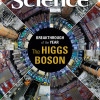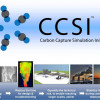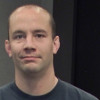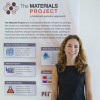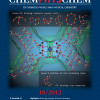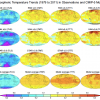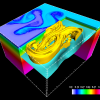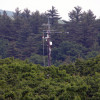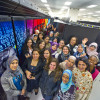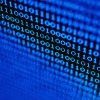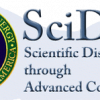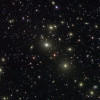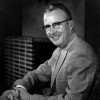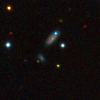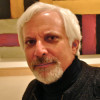News Center
CRD’s Daniel Burke Elevated to IEEE Senior Member
Daniel Burke, who joined the Computational Research Division last fall as a project manager for the new Computer Architecture Lab, has been elevated to the grade of Senior Member of the IEEE this year. Senior Member is the highest professional grade of the IEEE for which a member may apply and only about 8 percent of IEEE’s 416,000 members have achieved this level. Read More »
Berkeley Lab's CRD Contributes to Breakthroughs of the Year
Every year, Science magazine editors and staff sift through numerous scientific accomplishments and ultimately crown one “Breakthrough of the Year.” Of the top 10 finalists for 2012, Lawrence Berkeley National Laboratory (Berkeley Lab) computational researchers were major contributors to two accomplishments, including the winner: Discovery of the Higgs Boson. Read More »
Berkeley Lab Computer Scientists Developing Tools to Reduce Greenhouse Gases at the Source
Berkeley Lab computational scientists are playing key roles in the management of the Carbon Capture Storage Initiative (CCSI) project and development of the computational tools. CCSI is developing computational tools to help researchers design cost-efficient systems that will reduce the amount of CO2 emissions spewing from coal-fired power plants. Read More »
Boverhof’s App Earns Honorable Mention in Amazon’s Web Services Competition
The Turbine Gateway, an application developed by the Computational Research Division’s Joshua Boverhof for DOE’s Carbon Capture Simulation Initiative, recently earned honorable mention in a competition sponsored by Amazon Web Services(AWS). Amazon officially announced the winners of its EC2 Spotathon on Monday, Dec. 10. Read More »
CRD Researchers Receive 2013 INCITE Allocations
Two researchers from the Computational Research Division are principal investigators and four are co-investigators on projects receiving large allocations of computer time in 2013 under DOE’s INCITE program. Read More »
Can We Accurately Model Fluid Flow in Shale?
Shale is a sedimentary rock consisting of layered, fine-grained clay minerals and, often, organic matter such as kerogen, the source of oil and gas. Now, CRD researchers have developed a new mathematical model that incorporates kerogen in calculating how gas and oil become available and how long a reservoir is liable to keep producing. Read More »
Computational Researchers Help Develop Next-Gen Batteries
As part of DOE's new Batteries and Energy Storage Hub, NERSC and CRD expertise will be leveraged to predict the properties of electrolytes. When JCESR is up and running, collaborators will be able to combine these results with the existing Materials Project database to get a complete scope of battery components. Read More »
Wes Bethel is ACM Distinguished Scientist
Wes Bethel, leader of the Visualization Group in the Computational Research Division, has been named an ACM Distinguished Scientist. Read More »
Novel Tools and a Pharmaceutical Screening Strategy to Capture CO2
One of the major challenges to using zeolites for CO2 capture is identifying the right porous structures to effectively do the job. But novel tools developed by Berkeley Lab computational researchers, combined with an informatics screening strategy inspired by the pharmaceutical industry, is making this search a lot easier. Read More »
John Shalf Named Chief Technology Officer for NERSC
John Shalf has been named the Chief Technology Officer of the National Energy Research Scientific Computing (NERSC) Division at Lawrence Berkeley National Laboratory (Berkeley Lab). Shalf will also continue to serve in his current role as head of the Computer and Data Sciences Department in Berkeley Lab’s Computational Research Division (CRD). Read More »
Climate Change Study Strengthens Link to Human Activities
New research shows some of the clearest evidence yet of a discernible human influence on atmospheric temperature. Read More »
Modeling the Breaking Points of Metallic Glasses
Christopher Rycroft of Berkeley Lab’s Computational Research Division has developed some novel computational techniques to address why metallic glass alloys, or liquid metals, have such wildly different toughness and breaking points, depending on how they are made. Read More »
CRD and Berkeley Lab Staff Speak at Albany High School's Career Day
Dan Martin and Peter Nugent of Berkeley Lab's Computational Research Division, were among a group of 40 speakers who discussed their work and career paths at Albany High School's annual Career Day on Wednesday, Nov. 14. Read More »
Visualizing Oil Dispersion
Using visualization software developed for the fusion energy research community by computer scientists at Berkeley Lab, oceanographers found that they needed to factor in the interactions between deep, middle and surface ocean currents to successfully track pollutant dispersion in the Gulf of Mexico. Read More »
Department of Energy's Investment Ensures AmeriFlux Data for All
Twenty years ago, researchers began installing sensors in a variety of ecosystems to study how carbon dioxide cycles through the environment. Today, these sensors have been deployed at 120 locations across the Americas. Because the Department of Energy recognizes that these datasets could benefit a variety of scientific communities, it is funding an effort to make this data accessible to a wide-range of researchers. Read More »
CRD’s Sean Peisert Shares Cyber Security Expertise at I3P Meeting
Sean Peisert, a research scientist in Berkeley Lab's Computational Research Division, recently gave a presentation talk at the 10th Anniversary of the Institute for Information Infrastructure Protection (I3P), held Oct. 10 at the National Press Club in Washington, D.C. Peisert discussed the impact of I3P,s a consortium of leading universities, national laboratories and nonprofit institutions dedicated to strengthening the cyber infrastructure of the United States. Read More »
State Department’s TechWomen 2012 Visit Berkeley Lab
Berkeley Lab researchers in the Computational Research, Physics and Physical Biosciences Divisions also hosted three TechWomen—from Algeria, Lebanon and Tunisia—during the month of September. Launched by Secretary of State Hillary Rodham Clinton in 2011, TechWomen is an international exchange that uses technology as a means to empower women and girls in the Middle East and North Africa. Read More »
Berkeley Lab Helps Develop Software for Exascale Supercomputers
Expected to become available by the end of this decade, exascale supercomputers will be 1,000 times faster than today’s petascale machines. To address the challenge of developing a software stack for exascale systems, the U.S. Department of Energy is funding a number of research efforts under the X-Stack program. Computer scientists in the Computing Sciences organization at Berkeley Lab will contribute their expertise to three X-Stack projects. Read More »
Berkeley Lab Scientists to Lead, Support 14 New SciDAC Projects
When the Department of Energy announced the series of projects under the latest Scientific Discovery through Advanced Computing (SciDAC) program, Berkeley Lab scientists, mathematicians and computer scientists were listed as key contributors in three institutes and 11 science application partnerships. Funding for the projects is expected to total about $6 million annually over the next three to five years. Read More »
“Flying Through the Known Universe” Screens at 3D Film Festival in L.A.
A 3D movie flight through hundreds of thousands of galaxies at considerably faster than the speed of light has its world-premiere screening at the 3D Film Festival this Thursday, Sept. 20. Read More »
CRD Researchers Edit Book on High Performance Visualization
Wes Bethel and Hank Childs of CRD, along with Charles Hansen of the University of Utah, have edited the book High Performance Visualization: Enabling Extreme-Scale Scientific Insight. he book focuses on algorithm design, implementation, and optimization for visualization and analysis tools on emerging multi- and many-core platforms. Read More »
Now Accepting Applications for Alvarez Fellowship!
Apply now for the Luis W. Alvarez Postdoctoral Fellowship in Computational Science, sponsored by Lawrence Berkeley National Laboratory’s Computing Sciences Directorate. Researchers in computer science, applied mathematics or any computational science discipline who have received their Ph.D. within the last three years are encouraged to apply. The successful applicant will receive a competitive salary and excellent benefits.
Read More »
Berkeley Lab Computational Scientists to Help Illuminate Dark Universe
Aiming at illuminating the 95 percent of the universe known as dark matter and dark energy, researchers in Berkeley Lab’s Computational Research Division are working to boost the success of next-generation cosmology experiments. Read More »
Supernovae of the Same Brightness, Cut from Different Cosmic Cloth
The Palomar Transient Factory team, including researchers from CRD's Computational Cosmology Center, presents the first-ever direct observations of a Type 1a supernova progenitor system. Read More »
Financial Firms Support CIFT’s Assessment of HRC Role in Market Stability
CIFT has received $100,000 in research donations to study and promote the use of leading edge supercomputing and data intensive science for improving stability, regulation, and enforcement in U.S. markets. Read More »










